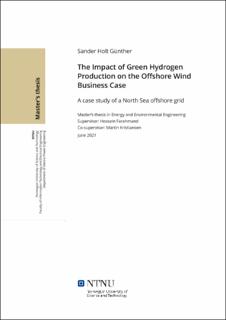| dc.description.abstract | The European Union recently decided to increase its climate ambition for 2030 and aims to reach climate neutrality by 2050. Achieving a climate neutral economy involves a vast expansion of European offshore wind and will require a large amount of hydrogen, especially in hard-to-abate industrial sectors. Such hydrogen will increasingly be produced on the basis of renewable sources, because only renewable-based hydrogen is fully carbonfree. While being essential in tackling emissions, low-carbon hydrogen can also act as a flexibility provider and help balancing seasonal variations in electricity generation from renewables.
In this thesis, a deterministic optimization model for power system expansion planning (PowerGIM) is formulated and demonstrated on a case study. The case study assesses new and effective ways of realizing the potential of offshore wind in the North Sea, through a transnational and cross-sector approach. The TYNDP 2020 Global Ambition scenario for 2040 is used as the main source of input data and included countries are Germany, Denmark, the Netherlands, Belgium, Great Britain, Norway and France. Primary targets are to investigate the utilization and utilization drivers of new transmission and generation capacity. A main focus is also dedicated to investigate the impact of hydrogen on the offshore wind business case.
Obtained results demonstrate that a high level of integration between countries is essential to unlock the full potential of large-scale offshore wind. Connecting new offshore wind capacity to Germany, Denmark and the Netherlands through hub configurations, compared to a radial configuration, is found to provide a higher utilisation of wind assets. However, new transmission capacity has a low value unless connections are included to the Norwegian and British market. It is also found that green hydrogen can serve as a facilitator for offshore wind integration, providing significant reductions in curtailment and increased revenue in the electricity market. Added load through new electrolyser capacity generally leads to a higher utilisation and capture prices for offshore wind. Conversely, when comparing a fixed and price dependent hydrogen load, it is observed that optimal charging from the grid enables the electrolyser to capture low electricity prices, significantly reducing the power costs of hydrogen production. Given the underlying assumptions it is calculated that the levelized cost of hydrogen could come down to C1.2-2.8/kg H2, provided a low-cost electricity supply and declining capital costs of electrolysers through 2040. | |
